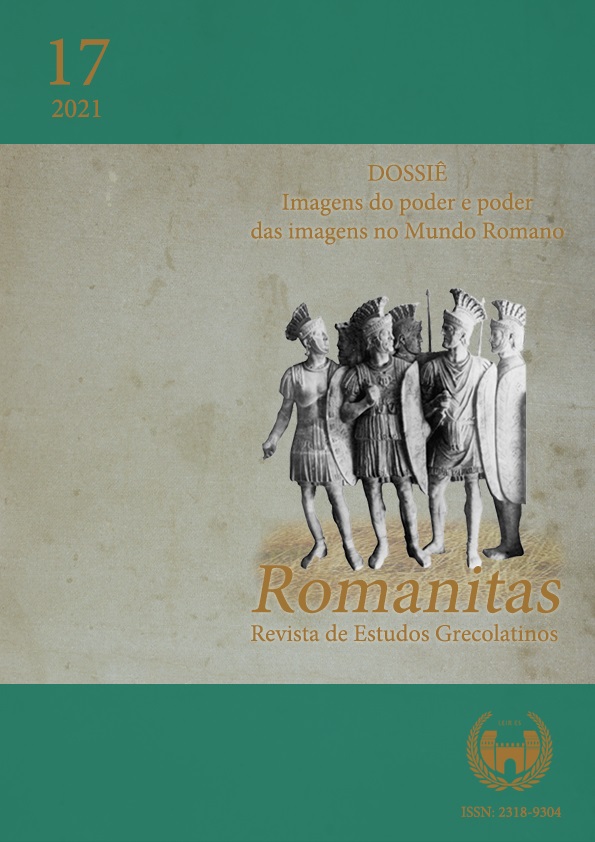Teodoro Estudita e sua oposição ao poder imperial: uma análise da Controvérsia Moechiana e da Segunda Iconoclastia
DOI:
https://doi.org/10.17648/rom.v0i17.35352Palavras-chave:
Teodoro Estudita, Controvérsia Moechiana, Iconoclastia, Poder Imperial, BizâncioResumo
Teodoro Estudita foi um monge que, no decorrer do século IX, foi uma importante força de oposição diante das decisões imperiais julgadas por ele como ultrajantes aos ideais cristãos bizantinos. Em duas ocasiões, colocou-se contrário ao imperador e suas ações, sofrendo consequências e punições, como o exílio. Em função disso, nosso objetivo se insere na tentativa de compreender o papel de Teodoro como agente de oposição ao palácio imperial e suas relações com ele, uma vez que os monges eram considerados importantes meios de contato e influência sobre a sociedade bizantina. Pretendemos fazer isso a partir do estudo de caso da Controvérsia Moechiana e da Segunda Iconoclastia (815-843), nas quais o monge foi protagonista.
Downloads
Referências
Documentação textual
GRUMEL, V. Le patriarcat byzantine, série I: les regestes des actes du patriarcat de Constantinople. Les actes patriarches, fasc. II et III. Les regestes de 715 à 1206. Paris: Institut Français d’Études Byzantines, 1989. v. 1.
TESTAMENT of Theodore the Studite for the Monastery of St. John Stoudios in Constantinople. In: THOMAS, J.; HERO, A. C. (ed.). Byzantine monastic foundation documents: a complete translation of the Surviving Founder’s Typika and Testaments. Washington: Dumbarton Oaks, 2000, p. 67-83.
Obras de apoio
ALEXANDER, P. J. Religious persecution and resistance in the Byzantine Empire of the eighth and ninth centuries: methods and justifications. Speculum, v. 52, n. 2, p. 238-264, 1977.
BENOIT-MEGGENIS, R. L’empereur et le moine: recherches sur les relations entre le pouvoir impérial et les monastères à Byzance, du IXe siècle à 1204. 2010. Tese (Doutorado em História) – École Doctorale en Sciences sociales, Université Lumière Lyon 2, Lyon, 2010.
CHARANIS, P. The monastic properties and the state in the Byzantine Empire. Dumbarton Oaks Papers, v. 4, p. 53-118, 1948.
CHOLIJ, R. Theodore the stoudite: the ordering of holiness. Oxford: Oxford Scholarship Online, 2009.
KAZHDAN, A. P. (ed.). The Oxford Dictionary of Byzantium. Oxford: Oxford University Press, 1991. v. 3.
McGUCKIN, J. The theology of images and the legitimation of power in eighth century Byzantium. St Vladimir’s Theological Quarterly, p. 39-58, 1993.
MEYENDORFF, J. Byzantine theology: historical trends and doctrinal themes. New York: Fordham University Press, 1979.
MILLER, T. Theodore Studites: Testament of Theodore the Studite for the Monastery of St. John Stoudios in Constantinople. In: THOMAS, J.; HERO, A. C. (ed.). Byzantine monastic foundation documents: a complete translation of the Surviving Founder’s Typika and Testaments. Washington: Dumbarton Oaks Research Library and Collection, 2000, p. 67-83.
MORRIS, R. Monks and laymen in Byzantium, 843-1118. Cambridge: Cambridge University Press, 1995.
OSTROGORSKY, G. Historia del Estado bizantino. Madrid: Akal, 1984.
STAMBOLOV, A. Monks and state: St Theodore the Studite and his relations to the State and Church authorities in Byzantium. Phronema, v. 30, n. 1, p. 137-165, 2005.
TREADGOLD, W. Breve historia de Bizancio. Barcelona: Paidós Ibérica, 2001.
Downloads
Publicado
Como Citar
Edição
Seção
Licença
Copyright (c) 2021 Caroline Coelho Fernandes

Este trabalho está licenciado sob uma licença Creative Commons Attribution-NonCommercial-NoDerivatives 4.0 International License.
a. Os autores mantêm os direitos autorais e concedem à revista o direito de primeira publicação.
b. Os autores têm autorização para assumir contratos adicionais separadamente, para distribuição não-exclusiva da versão do trabalho publicada nesta revista (ex.: publicar em repositório institucional ou como capítulo de livro), com reconhecimento de autoria e publicação inicial nesta revista.
c. Autores têm permissão e são estimulados a publicar e distribuir seu trabalho online (ex.: em repositórios institucionais ou na sua página pessoal) após a primeira publicação pela revista, com os devidos créditos.
d. Os textos da revista estão licenciados com uma Licença CC BY 4.0 Deed Atribuição 4.0 Internacional (CC BY).




























